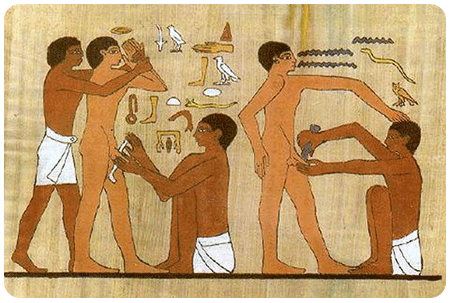|
|
|
|
|
 |
Circumcision, which can be described as cutting out the prepucium, is one of the oldest surgical operations of the human history. Besides its being a long term tradition, it is the most frequent surgical operation. Debates on circumcision go on increasing as a result of medical, religious and cultural diversities. Above the debates, in many society and culture circumcision is carried out according to religious beliefs and traditions without concerning its medical advantages. Nowadays, it is known that half of the male population in Canada and US; and 1/6 of the world’s male population have circumcision operation. In Turkey, this ratio is 100%. According to a research that was carried out in 1990s, it is estimated that 80% of male infants in US have been circumcised (5). Extreme diversities in circumcision rates around the world is based on the cultural differences. In 19th century, the practice of routinely circumcising the infants has started with the aim of protecting against illnesses and in a short time it was accepted in especially English speaking countries. Today in US, infant circumcision is one of the widely practiced operations. Circumcision is one of the oldest surgical operations that is carried out by societies. It is known that circumcision is practiced by different cultures and these cultures have their unique techniques and traditions. When Kristof Kolomb explored the new world he saw that most of the Indians were circumcised. Anthropologists are not agree on a similar opinion about whom performed the circumcision first and when it was practiced for the first time. According to many scientists who study on the origin of circumcision, it was started to be carried out by different cultures and independent from each other. It is known that in many different cultures such as Southeast Asia, Africa and Australian Indians circumcision is widely performed. There are proofs that it has been carried out for about 4000 years. |

Sir Grefton Eliot Smith, who studies on Egypt history, claimed that circumcision practice might have been started in heliotic era about 15000 years ago. In the studies of anthropologist Ashley Montagu, it became absolute that there were circumcision operations in ancient Egypt 6000 years ago. In the Old Testament, 4000 years ago, it is stated that there was a circumcision practice in 8th day of the birth. The drawings related with circumcision on temples that were constructed in Pharaoh era are the evidences that show circumcision is a traditional operation which has a long history. In that era, circumcision was held by the reverends who was living in the temple. In Ancient Egypt, circumcision was used as a symbol of slavery. Before that, captured slaves were castrated and their fingers were imputed. But these operations increased morbidity and as a result the number of the slaves was decreasing. In that period, circumcision is a humiliating and insulting situation. For that reason, they gave up all other operations and started to circumcise the slaves. In some cultures, the one who was circumcised was a kind of sacrifice for the gods and the purpose was to ask for good crop from the gods. The blood that drop during the circumcise was mixed with wheat and eaten. In Nicaragua, there was evidence that people ask for abundant crop from the god.
Another reason for circumcision is that it is seen as an aesthetic operation. With the circumcision, whether the penis become more aesthetic or not is not meaningful because it can change according to cultures, people and preference. Whether the circumcised penis is more preferable or not depends on the traditions and values in that society.
The third reason is related with the advantages related with health. This topic is a long termed debate. There are important advantages that circumcision provides. In circumcised people the rate of infections of the contagious illnesses that are transmitted by sexual intercourse as the prepucium is cut out. Circumcision in early period decreases the rate of urinary infection in an important amount. Prophylaxis aimed circumcision against illnesses has become routine in 19th century. Between 1940s and 1970s circumcision was accepted as a weapon against genital illnesses but after 1960 there appeared opinions that circumcision was a potential risk. In 1975 American Podiatry Academy (APA) stated that circumcision should not be done routinely in infants. After 1980s this idea started to change. In 1989, APA declared that infant circumcision has potential medical advantages and also risk and disadvantages, so before the operation the parents should be informed about these situations. In 1999 report, it was stated that circumcision is an operation that provide long termed protective effects but these advantages were not enough to recommend routine circumcision exercises. Recent studies show that the rate of AIDS infection in circumcised males is much low.
So ever the real origin of the circumcision is not known; the studies and as a result of them the proposed theories show that: circumcision dates back a long time, whatever the reason is.
|
REFERENCE
1. Griffith D, Frank JD. Inappropriate circumcision referals by GPs. J R SocMed 1992; 85: 324-5.
2. Koo HP, Duckett JW. Circumcision-Quo Vadis? Pediatrik Cerrahi Dergisi1995; 9: 149-54.
3. Yurdakök M. Tarihte sünnet. Çocuk Saglıgı ve Hastalıkları Dergisi 2000;43: 303-11.
4. Tekgül S. Sünnet. Çocuk Saglıgı ve Hastalıkları Dergisi 2000; 43: 297-302.
5. Dayanç M. Sünnet. Güncel Çocuk Ürolojisi.1.baskı. Ankara: Atlas Yay.2004; 281-93.
6. Ellis DG, Mann CM. Abnormalities of the urethra, penis and scrotum.O’Neill JA, Rowe MI, Grosfelt JL, Fonkalsrud EW, Coran AG. Pediatric Surgery 5th edition. St. Louis , Mosby-year Book, Inc 1998; 1783-95.
7. Cold CJ, Taylor R. The prepuce. BJU Int 1999; 83 Suppl 1: 34-44
8. Çaman Ş. Prepisyumda Balanitis Xerotica Obliterans Varlığının araştılılması. Uzmanlık Tezi 2005
|
|
|
|
|
|

